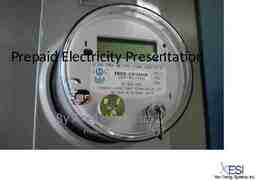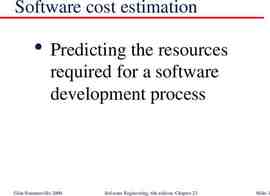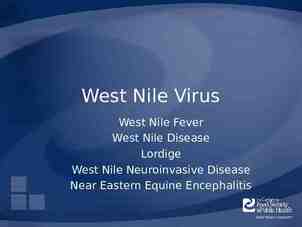LECTURE #5 Chapter 4 –Water Quality (Hwk#4- pp.112-113 2,4,6,10,14)
14 Slides202.00 KB

LECTURE #5 Chapter 4 –Water Quality (Hwk#4- pp.112-113 2,4,6,10,14) Chemistry Review Compound – A combination of Elements Molecule – Smallest part of a Chemical compound organic vs. inorganic- complex molecules of carbon in combinations with other elements is organic(i.e. organic pertains to living organisms and an exception would be CO2) covalent vs. ionic bonding – shared electron atomic structure (covalent) vs. positive and negative charge attraction (ionic)[H20 .vs. NaCl] electron neutron proton

Chapter 4 –Water Quality (Hwk#4- pp.121-122 2,4,6,10,14) Chemistry Review Solutions – a uniform mixture of two substances (solid, liquid, or gas) Solvent – the largest substance found in the solution Solutes – the smaller amount of the substances in a solution Solubility Properties – Liquids (the warmer the more soluble), Gas (the warmer the less soluble, the lower the pressure, the lower the solubility) [i.e. sugar in water, oxygen in water (table 4.3), exception is alcohol in water]

Chemistry Review ionization– The dissociation or breaking apart of molecules (to charged particles) when dissolved into solution.[ NaCl Na Cl ] radicals – The dissociation of molecules into groups of atoms. [ H 2O H OH ] OH is the hydroxyl radical. Suspension vs. Colloids – Colloids are particles less than coarse suspension but gt. than the true solution [ 0.1цm] and don’t settle in the solution. [i.e. clay in water and fog in air are both colloids] Tyndall effect – the scattering of light in a solution by colloids

Chemistry Review Flocculation– The clumping together of colloidal particles by neutralizing the colloidal charges. dilute .vs. saturation – qualitative descriptions for the concentration of solutes in a solution. Concentration Units – mg/L 1ppm,μg/L 1ppb, 1gpg 17.1 mg/L (for air - μg/m3) [1L of water weighs 1kg therefore 1L is equivalent to 106mg], i.e. 3.5% 35000mg/L, 1mg/L 8.34#/million gallons

Chemistry Review Acid – A substance that causes an increase in hydrogen ions, H Base- A substance that causes an increase in hydroxyl radicals, OH pH – a dimensionless scale that measures alkalinity or acidic substance from 0 to 14.(the negative logarithm of the hydrogen ion concentration) [i.e. water numerical value of the hydrogen ion concentration is ten to the minus seven. A ph of 5 is ten times more acidic than a ph of 6, because it is logarithmic to the base 10-pp.90]

Chemistry Review Organic Substances– molecular structure {Carbon plus some other elements} Organic compounds .vs. Organic chemicals Hydrocarbons – contains only carbon and hydrogen (i.e. Methane CH4[found in the decay process of sewage and sludge], Benzene C6H6 [simplest ring hydrocarbon]) pp.90-91 Organic chemicals (i.e. Alcohols) - Methanol CH3OH,hydrogen is replaced by hydroxyl radicals. i.e. solvents &fuel additives/Ethanol is a result of the fermentation of sugar and is used for alcoholic beverages. H H c H H H H c H O H

Chemistry Review Biodegradable – term for substances that can be broken down by microbes into simpler molecules Carbohydrates –(contains C,O, and H) the basic product of photosynthesis and are biodegadable organic compounds.[i.e. glucose,sucrose (table sugar),etc.] Starch and cellulose are more complex carbohydrates fats are not very soluble in water Proteins – –(contains C,O, H,N and S) are formed from amino acids are much more complex than carbohydrates

Water Quality Turbidity– suspended particles which scatter light and create a murky or cloudiness in the water Turbidity Unit (TU)–It is correlated to the interference of light passage in 1 mg/L of suspended silica. The nephelometers measure TUs. (TU 5 is not noticeable)pp. 92 Temperature – fish optimum temperatures ranges between 15-32 degrees (i.e trout-15 , perch-24 ,carp –32 ) note: increase in water temperature decrease oxygen solubility. Color, taste, odor – important for drinkability. i.e.hydrogen sulfide gas is produced from decaying organic matter. Threshold #- the amount of water required to dilute the sample to remove the smell over the original volume.

Chemical Parameters Dissolved Oxygen (DO)- is important for aquatic life as well as land animals. ( 9ppm @20ºc in water) Biochemical Oxygen Demand (BOD)- The need for oxygen when microbes consume the DO while breaking down organic substances Note: the higher the organic material the higher the BOD.(expressed as mg/L of oxygen) BODL-ultimate BOD or the maximum amount of oxygen needed to biodegrade a given volume of waste.(BOD 10mg/L has sewage pollution) kt BODt BODL x (1 10 ) where k .15 / d @ 200 c, rate of BOD reaction t time, d BODt BOD at time t , mg / L BODL BOD at the ultimate carbonaceous level , mg / L ( DO0 DO5 ) x300 BOD5 V where DO0 DO at time t 0 DO5 DO at time t 5d V sample volume, mL

Chemical Parameters Nitrification- when microorganism begin feeding on noncarbonaceous ammonia after 8 to 10 days Chemical Oxygen Demand(COD)-it measures all organics, including nonbiodegradable substances. This test can not be correlated to the BOD test. Total Dissolved Solids(TDS)- The solids that remain as a residue after evaporating the sample from a dish Total Suspended Solids(TSS)- The solids that are retained on the filter ([ wt of dish residue] wt of dish) x1000{in mg} volume of sample filtered , mL ([ wt of filter solids ] wt of filter ) x1000{in mg } TSS volume of sample filtered , mL TDS

Chemical Parameters volatile solids- burns off at 550ºc Hardness-term to express the properties of highly mineralized water (i.e. the concentration of Calcium and Magnesium in water from soils and rocks) all organics, including nonbiodegradable substances. This test can not be correlated to the BOD test. Gas Chromotography/Mass Spectrometry-tests for organics substances Atomic Absorption Spectrophotometers- detect heavy metals

N am e of S u b s ta n c e Iro n , M a n g a n e s e , C o p p e r , a n d Z in c F lo u r id e C h lo r in e S u lfa te s N itr o g e n P h o s p h o ru s H e a lt h R is k none g o o d d e n ta l h e a lth n o n e - d ilu te d c a n fo r m tr ih a lo m e th a n e s ( c a r c in o g e n ) none h ig h le v e ls o f n itr a te s c a n e ffe c t in fa n ts u n d e r 3 m o n th s none A c id ity , A lk a lin ity , and pH n o n e w ith in n o r m a l p h lim its o f 6 - 9 .5 h e a v y m e ta ls to x ic - c a r c in o g e n s le a d in g to d e a th r a d ia tio n to x ic - d u e to u n s ta b le n u c le i e m ittin g e n e r g y W a te r E ffe c ts b itte r ta s te , tu r b id w a te r , c a u s e s s ta in in g d is c o lo r e d te e th w h e n c o n s u m e in e x c e s s d is in fe c ta n t a n d p r o d u c e s a n ita r y w a s te .C a n fo r m C h lo r o fo r m w h e n m ix e d w ith o r g a n ic s ( p r e c u r s o r s ) c a n c r e a te b a d ta s te a n d la x a tiv e e ffe c t. In s e w a g e c a n fo rm H y d r o g e n S u lfid e w ith a b a d s m e ll p r o m o te s p la n ts g r o w th , s u c h a s a lg a e w h ic h d e g r a d e s w a te r q u a lity ( e u tr o p h ic a tio n ) p r o m o te s p la n ts g r o w th , s u c h a s a lg a e w h ic h d e g r a d e s w a te r q u a lity ( e u tr o p h ic a tio n ) e le v a te d lim its c a n c a u s e b a d ta s te ( a c id a r e s o u r , b a s e s a r e b itte r ) n o t a lw a y s n o tic e a b le d u e to a tra c e a m o u n t n o t a lw a y s n o tic e a b le d u e to a tra c e a m o u n t

Nam e of M ic r o -o r g a n is m B a c te r ia a e r o b ic a n d a n a e r o b ic b a c t e r ia ( C a n b e f ilt e r e d ) a lg a e (c a n b e filte r e d ) P ro to z o a (c a n b e filte r e d ) V ir u s e s (c a n n o t b e filte r e d ) d e fin it io n T h r o u g h b in a r y f is s io n t h e y f o r m c o lo n ie s T h e y re p ro d u c e fa s te r in w a r m e r t e m p e r a tu r e s - T h e y a r e a u to tr o p h ic a n d c a n c o n v e rt in o r g a n ic m a tt e r in t o o r g a n ic u s in g t h e s u n a n d c h lo r o p h y ll - T h e s im p le s t o f t h e a n im a l s p e c ie s ( s in g le c e lle d ) s m a ll p a th o g e n s w h ic h ta k e o v e r a h o s t c e ll m e ta b o lic p r o c e s s f o r t h e ir o w n u s e E ffe c ts - e x c e s s iv e g r o w th r e d u c e s s e w a g e tr e a tm e n t e ffic ie n c y - a u to tr o p h ic b a c te r ia c a n fe e d o n s im p le in o r g a n ic c o m p o u n d s - h e te r o tr o p h ic b a c te r ia fe e d o n c o m p le x o r g a n ic s u b s ta n c e s - T h e y a r e c a lle d P h y to p la n k to n a n d p ro d u c e 9 0 % o f o x y g e n - T h e y a r e a p r o b le m fo r p u b lic w a te r b e c a u s e o f th e ta s te a n d o d o r p r o b le m s . - It is e x p e n s iv e to filte r it o u t o f th e w a te r - T h e y a r e c a lle d z o o p la n k to n -T h e y c a n c a u s e d y s e n te ry a n d g a s tr o in te s tin a l d is e a s e th e c a u s e o f c h ic k e n p o x , r a b ie s , y e llo w fe v e r , p o lio , c o ld s , e t.c in a c tiv a tio n is d o n e th r o u g h d is in fe c tio n

Chemical Parameters coliforms- bacteria that is always present in the human intestinal tract (E.coli) [no coliform –no sewage – no pathogens] Two methods for tesing: Membrane Filter Method Mulitple –Tube Fermentation Method






